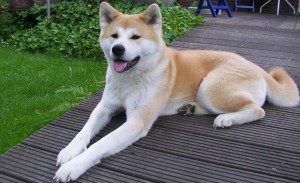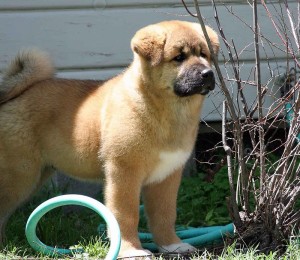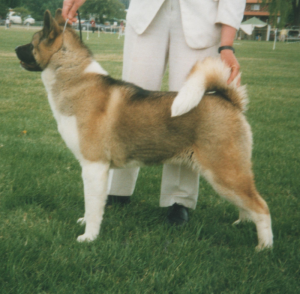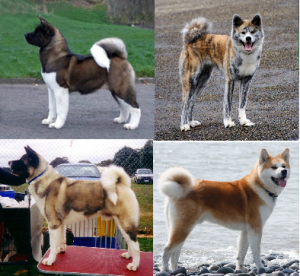The Akita is a large breed of dog originating from the mountainous northern regions of Japan. There are two separate varieties of Akita: a Japanese strain, commonly called "Akita Ken" in Japan, "Akita Inu" ("inu" means "dog" in Japanese), "Japanese Akita"; and an American strain, known as the "Akita" or "American Akita". The Japanese strain comes in a narrow palette of colors, with all other colors considered atypical of the breed, while the American strain comes in all dog colors. The Akita has a short double coat, similar to that of many other northern spitz breeds such as the Siberian Husky, but long coated dogs can be found in many litters due to a recessive gene.
The Akita is a powerful, independent and dominant breed, commonly aloof with strangers but affectionate with family members. As a breed, Akitas are generally hardy, but they have been known to suffer from various genetic conditions and be sensitive to certain drugs.
In most countries, the American strain of Akita is now considered a separate breed. In the United States and Canada, however, the two strains are considered a single breed with differences in type. For a while, the American strain of Akita was known in some countries as the "Great Japanese Dog". Both forms of Akita are probably best known worldwide from the true story of Hachikō, a loyal Akita who lived in Japan before World War II.
Breed name
There is debate among fanciers whether there are two separate breeds of Akita. To date, only the American Kennel Club, and the Canadian Kennel Club consider American and Japanese Akitas to be two varieties of the same breed, allowing free breeding between the two. The Federation Cynologique Internationale, The Kennel Club, the Australian National Kennel Council, the New Zealand Kennel Club, and the Japan Kennel Club consider Japanese and American Akitas as separate breeds. Some countries refer to the American Akita as simply the "Akita" and not the American Akita. The issue is especially controversial in Japan. For the FCI's 84 countries, the breed split formally occurred June 1999, when the FCI decided that the American type would be called the Great Japanese Dog, later renamed the American Akita in January 2006.
History
Japanese history
Japanese history, both verbal and written, describe the ancestors of the Akita, the Matagi dog(Japenese)(hunting dog, Bear hunting dog, Deer hunting dog), as one of the oldest of the native dogs. Today's Akita developed primarily from dogs in the northernmost region of the island of Honshū in the Akita prefecture, thus providing the breed's name. The Matagi's quarry included wild boar, Sika deer, and Asian black bear. This precursor dog tracked large game, holding it at bay until hunters arrived to make the kill. The breed is also influenced by crosses with larger breeds from Asia and Europe, including English Mastiffs, Great Danes, St. Bernards, and the Tosa Inu, in the desire to develop a fighting dog for the burgeoning dog fighting industry in Odate in the early 20th century.[12] During World War II the Akita was also crossed with German Shepherd Dogs in an attempt to save them from the wartime government order for all non-military dogs to be culled. The ancestors of the American Akita were originally a variety of the Japanese Akita, a form that was not desired in Japan due to the markings, and which is not eligible for show competition.
Just as the breed was stabilizing in its native land, World War II pushed the Akita to the brink of extinction. Early in the war the dogs suffered from lack of nutritious food. Then many were killed to be eaten by the starving populace, and their pelts were used as clothing. Finally, the government ordered all remaining dogs to be killed on sight to prevent the spread of disease. The only way concerned owners could save their beloved Akitas was to turn them loose in remote mountain areas, where they bred back with their ancestor dogs, the Matagi, or conceal them from authorities by means of crossing with German Shepherd dogs, and naming them in the style of German Shepherd dogs of the time. Morie Sawataishi and his efforts to breed the Akita is a major reason this breed exists today.
During the occupation years following the war, the breed began to thrive again through the efforts of Sawataishi and others. For the first time, Akitas were bred for a standardized appearance. Akita fanciers in Japan began gathering and exhibiting the remaining Akitas and producing litters in order to restore the breed to sustainable numbers and to accentuate the original characteristics of the breed muddied by crosses to other breeds. U.S. servicemen fell in love with the Akita and imported many with them upon their return.
American history
The Japanese Akita and American Akita began to diverge in type during the Post–World War II era. It was during this time, that US servicemen serving as part of the occupation force in Japan first came into contact with the Akita, the breed so impressed them that many soldiers chose to bring an Akita back home with them upon completion of their tour. American soldiers were typically more impressed with the larger more bear-like fighting Akita or German Shepherd type than they were with the smaller framed and fox-like Akita-Inu; the types of dogs they brought back with them to the US reflected this sentiment. Japanese Akita fanciers focused on restoring the breed as a work of Japanese art or to 'Natural Monument' status. American Akita fanciers chose to breed larger, heavier-boned and more intimidating dogs. Although, both types derive from a common ancestry, there are marked differences between the two. First, while American Akitas are acceptable in all colors, Japanese Akitas are only permitted to be red, fawn, sesame, white, or brindle. Additionally, American Akitas may be pinto and/or have black masks, unlike Japanese Akitas where it is considered a disqualification and not permitted in the breed standards. American Akitas generally are heavier boned and larger, with a more bear-like head, whereas Japanese Akitas tend to be lighter and more finely featured with a fox-like head.
Recognized by the American Kennel Club in 1955, it was placed in the Miscellaneous class. It was not until the end of 1972 that the AKC approved the Akita standard and it was moved to the Working dog class, as such, the Akita is a rather new breed in the United States. Foundation stock in America continued to be imported from Japan until 1974 when the AKC cut off registration to any further Japanese imports until 1992 when it recognized the Japan Kennel Club. The decision by the AKC to disallow the registration of any further imported dogs in 1974, set the stage for the divergence in type between the American Akita and Japanese Akita Inu that is present today.
Description
Appearance
As a spitz breed, the appearance of the Akita reflects cold weather adaptations essential to their original function. The Akita is a substantial breed for its height with heavy bones. Characteristic physical traits of the breed include a large, bear-like head with erect, triangular ears set at a slight angle following the arch of the neck. Additionally, the eyes of the Akita are small, dark, deeply set and triangular in shape. Akitas have thick double coats, and tight, well knuckled cat-like feet. Their tails are carried over the top of the back in a gentle or double curl down the loin.
Mature American type males measure typically 26–28 inches (66–71 cm) at the withers and weigh between 100–130 lb (45–59 kg). Mature females typically measure 24–26 inches (61–66 cm) and weigh between 70–100 lb (32–45 kg). The Japanese type, as stated in the breed standards, are a little smaller and lighter.
Breed standards state that all dog breed coat colors are allowable in the American Akita, including pinto, all types of brindle, solid white, black mask, white mask, self-colored mask, even differing colors of under coat and overlay (guard hairs). This includes the common Shiba Inu coloring pattern known as Urajiro. The Japanese Akitas, as per the breed standards, are restricted to red, fawn, sesame, brindle, pure white, all with "Urajiro" markings i.e., whitish coat on the sides of the muzzle, on the cheeks, on the underside of jaw, neck, chest, body and tail and on the inside of the legs.
Coat types
There are two coat types in the Akita, the standard coat length and the long coat. The long coat is considered a fault in the show ring, however. The long coat, also known as 'Moku' is the result of an autosomal recessive gene and may only occur phenotypically if both sire and dam are carriers. They have longer (about 3–4 inches in length) and softer coats and are known to have sweeter temperaments. It is believed that this gene comes from the now extinct Karafuto-Ken.
Grooming needs
American Akitas are a low maintenance dog breed. Grooming them should be an easy process. They are fairly heavy shedders and can go heavier than normal two to three times per year. Daily brushing could be a good way to reduce this problem. This breed needs to bathe every few months, although it can be more often, depending on the needs of each owner. Toenails should be trimmed every month, and their ears should be cleaned once a week.
Temperament
The Akita is generally seen as territorial about its property, and can be reserved with strangers. It is sometimes described as feline in its actions; it is not unusual for an Akita to clean its face after eating, to preen its kennel mate, and to be fastidious in the house. They are known to be intolerant of other dogs of the same sex, as stated in the AKC breed standard.
Since it is a large, powerful dog, the Akita is not considered a breed for a first time dog owner. The breed has been targeted by some countries' breed-specific legislation as a dangerous dog. The Akita is a large, strong, independent and dominant dog. A dog with the correct Akita temperament should be accepting of non-threatening strangers, yet protective of their family when faced with a threatening situation. They are usually docile, aloof and calm in new situations. As a breed they should be good with children; it is said that the breed has an affinity for children. Not all Akitas will necessarily have the same temperament.
The Akita was never bred to live or work in groups like many hound and sporting breeds. Instead, they lived and worked alone or in pairs, a preference reflected today. Akitas tend to take a socially dominant role with other dogs, and thus caution must be used in situations when Akitas are likely to be around other dogs, especially unfamiliar ones. In particular, Akitas tend to be less tolerant of dogs of the same sex. For this reason, Akitas, unless highly socialized, are not generally well-suited for off-leash dog parks. The Akita is said to be careful, courageous, fearless, and intelligent. Sometimes spontaneous, it needs a confident, consistent handler, without which the dog will be very wilful and may become very aggressive to other dogs and animals.
Breed specific conditions
There are two breed specific conditions mentioned in veterinary literature:
- Immune Sensitivity to vaccines, drugs, insecticides, anesthetics and tranquilizers
- Pseudohyperkalemia, a rise in the amount of potassium that occurs due to its excessive leakage from red blood cells (RBCs) when blood is drawn. This can give a false indication of hyperkalemia on lab tests, hence the prefix pseudo, meaning false. This occurs because many eastern Asian breeds, including Akitas and Shiba Inus, have a higher level of potassium in their RBCs than other dogs.
|
American Akitas (left) and Japanese Akitas (right) |
|||||||||||||||||||||||||||||||||
| Other names | Aykita ken, Japanese Akita, American Hakita, Great Japanese Dog (Obsolete) | ||||||||||||||||||||||||||||||||
|---|---|---|---|---|---|---|---|---|---|---|---|---|---|---|---|---|---|---|---|---|---|---|---|---|---|---|---|---|---|---|---|---|---|
| Country of origin | Japan | ||||||||||||||||||||||||||||||||
|
|||||||||||||||||||||||||||||||||
|
|||||||||||||||||||||||||||||||||
| Notes | National dog of Japan, Prefecture animal of Akita |
||||||||||||||||||||||||||||||||






